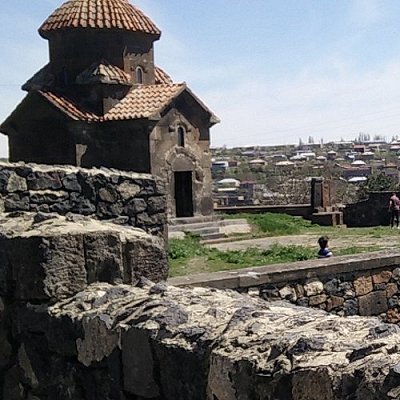
Like us on Facebook
PLACE NAMES



|
| Ashtarak |
 |
|
Ashtarak is a town in the Ashtarak Municipality of the Aragatsotn Province of Armenia, located on the left bank of Kasagh River along the gorge, 20 kms northwest of the capital Yerevan. It is the administrative centre of the province and an important crossroad of routes for the Yerevan–Gyumri–Vanadzor triangle.
The town plays a great role in the national economy as well as the cultural life of Armenia through several industrial enterprises and cultural institutions. It has developed as a satellite town of Yerevan. The nearby village of Mughni is part of the Ashtarak municipality.
As of the 2011 census, the population of the town was 18,834. However, as per the 2016 official estimate, the population of Ashtarak is 18,000. The prelacy of the Diocese of Aragatsotn of the Armenian Apostolic Church is headquartered in Ashtarak.
The name of "Ashtarak" is the Armenian word for tower or fortress. However, according to linguist Grigor Ghapantsyan, the name of Ashtarak is derived from Ishtar (Ashtar); the Assyrian and Babylonian goddess of fertility. Contrary, the latest historical researches proved that the name of Ishtar was never used in the Armenian mythology during the ancient times. Instead, the goddess of fertility was known as Shardi or Sardi in the ancient kingdom of Urartu, and later became known as Astghik among the Armenian monks. Other linguists suggest that the name of Ashtarak is related either with the legendary figure in the Armenian history Shidar; the son of king Artavasdes I of Armenia, or with Sarduri II; the king of Urartu.
The Bronze Age necropolises of Nerkin and Verin Naver are located just outside of modern Ashtarak. Archaeologist Hakob Y. Simonyan believes that they were constructed by an Indo-European culture, potentially early Armenians.
According to Movses Khorenatsi, Armanak, the son of the patriarch and founder of the Armenian nation Hayk, along with his clan, settled in the area of modern-day Aragatsotn.
Historically, the area of modern-day Ashtarak was part of the Aragatsotn canton of Ayrarat province of the ancient Kingdom of Armenia. The town is one of the oldest settlements in Armenia with many historical and cultural monuments that demonstrate the unique aspects of Armenian architecture.
In the history of the Armenian highland, Ashtarak was mentioned as a rural settlement for the first time during the 9th century. However, the importance of Ashtarak has declined during the following centuries under the rule of the foreign powers. Between the 11th and 15th centuries, the entire region of Aragatsotn along with the rest of the historic territories of Armenia suffered from the Seljuk, Mongol, Ag Qoyunlu and Kara Koyunlu invasions, respectively.
At the beginning of the 16th century, Ahtarak became part of the Erivan Beglarbegi within the Safavid Persia. During the 17th century, the town was entirely rebuilt. During the first half of the 18th century, Ashtarak became part of the Erivan Khanate under the rule of the Afsharid dynasty and later under the Qajar dynasty of Persia. Ashtarak was the site of the Battle of Oshakan in August 1827, which resulted in a Persian victory, during the Russo-Persian War of 1826-1828. It remained under the Persian rule until 1827-1828, when Eastern Armenia was ceded to the Russian Empire as a result of the same Russo-Persian War of 1826–28 and the signing of the Treaty of Turkmenchay.
After the fall of the Russian Empire in 1917, Ashtarak was included within the First Republic of Armenia declared on 28 May 1918. However, after 2 years of brief independence, Armenia became part of the Soviet Union in December 1920. From 1930 until 1995, Ashtarak was the centre of the Ashtarak raion. During that period, Ashtarak was granted the status of a town in 1963.
After the independence of Armenia in 1991, Ashtarak became the capital of the newly-formed Aragatsotn Province as a result of the territorial administration reform of 1995.
|
 Feel free to Email me any additions or corrections Feel free to Email me any additions or corrections
LINKS AVAILABLE TO YOUR SITE
| |





